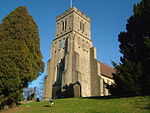Chestnuts Long Barrow, also known as Stony Warren or Long Warren, is a chambered long barrow near the village of Addington in the south-eastern English county of Kent. Probably constructed in the fifth millennium BC, during Britain's Early Neolithic period, today it survives only in a ruined state.
Archaeologists have established that long barrows were built by pastoralist communities shortly after the introduction of agriculture to Britain from continental Europe. Representing an architectural tradition of long barrow building that was widespread across Neolithic Europe, Chestnuts Long Barrow belongs to a localised regional style of barrows produced in the vicinity of the River Medway. The long barrows built in this area are now known as the Medway Megaliths. Chestnuts Long Barrow lies near to both Addington Long Barrow and Coldrum Long Barrow on the western side of the river. Two further surviving long barrows, Kit's Coty House and Little Kit's Coty House, as well as the destroyed Smythe's Megalith and possible survivals as the Coffin Stone and White Horse Stone, are on the eastern side of the Medway.
The long barrow was built on land previously inhabited in the Mesolithic period. It consisted of a sub-rectangular earthen tumulus, estimated to have been 15 metres (50 feet) in length, with a chamber built from sarsen megaliths on its eastern end. Both inhumed and cremated human remains were placed within this chamber during the Neolithic period, representing at least nine or ten individuals. These remains were found alongside pottery sherds, stone arrow heads, and a clay pendant. In the 4th century AD, a Romano-British hut was erected next to the long barrow. In the 12th or 13th century, the chamber was dug into and heavily damaged, either by treasure hunters or iconoclastic Christians. The mound gradually eroded and was completely gone by the twentieth century, leaving only the ruined stone chamber. The ruin attracted the interest of antiquarians in the 18th and 19th centuries, while archaeological excavation took place in 1957, followed by limited reconstruction. The site is on privately owned land.










